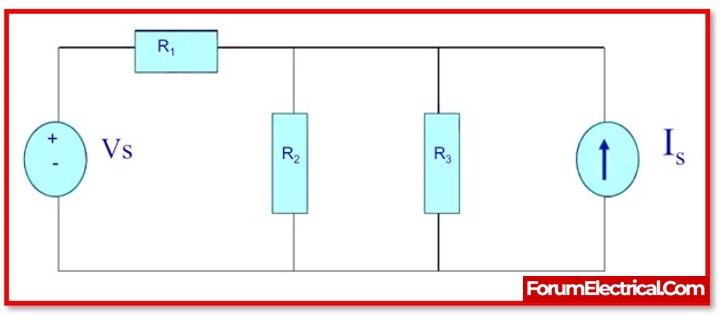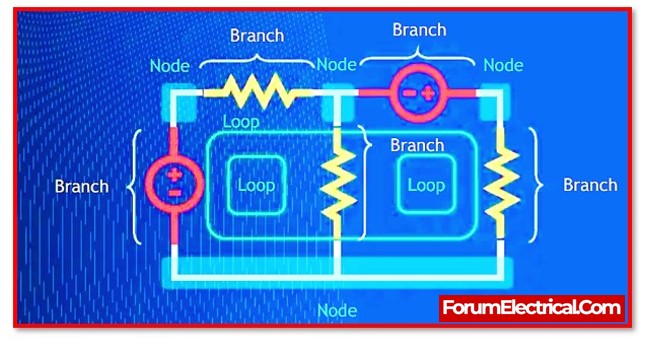A node, a branch, and a loop are the three fundamental elements that make up an electric circuit.
An electric network is defined as a collection of components of separate circuits that are linked to one another.
A closed channel for an electric current to pass across a network may (or) may not be provided by a network.
Nevertheless, a closed channel for electric current may be provided by a combination of one (or) more network, making up what is known as an electrical circuit.
In other words, an electric circuit is created whenever two or more networks are linked together in such a way as to finish completing one or more routes leading to the current.

EXAMPLE: CLOSED CIRCUIT WITH INPUT VOLTAGE VS, CURRENT IS AND CONNECTED RESISTORS R1,R2,R3
Nodes of the Electric Circuit
The point at which a circuit element is linked to the circuit is referred to as a node. A node is a location where the terminals of two (or) more circuit components are joined together.
A node is the circuit connection point.
A node is a point at which many wires connect to form a junction. Each point on a node carries the same value of potential (same voltage).
It is possible to recombine two (or) more connected adjoining nodes into a single node if there is no element between the two (or) more nodes.
THREE NODES CAN BE DETERMINED FROM EXAMPLE
Branch of the Electric Circuit
An electric circuit’s components are typically two terminal elements.
When one circuit element is connected (linked) to the circuit, it connects to itself through both terminals to form the closed path.
When any of the circuit components is connected (linked) to the circuit, it is unquestionably connected between two circuit nodes.
When an element exists(appears) between two nodes, the path from one to the other through this element is referred to as a branch of the circuit.
The branch of an electric circuit may be described more accurately, as the segment of the circuit between two nodes that can supply or absorb energy.
According to this definition, a short circuit between two nodes is not a branch of an electric circuit.
A branch is the section of a circuit that may be found between two junctions indicating that it may be a voltage source, current source, resistor, etc., with any two terminals.
FIVE BRANCHES CAN BE DETERMINED FROM EXAMPLE
Loops in the Electric Circuit
Several nodes are present in a circuit that conducts electricity.
It completes one circuit loop by travelling from one node to another and back to the original node without re-crossing any of the intermediate nodes.
The following theorem of circuit & network topology allows to locate loops:
l = b – n + 1
Where,
l – Total Number of Loops
b – Total Number of branches
n – Total Number of nodes
THREE LOOPS CAN BE DETERMINED FROM EXAMPLE
Mesh in the Electric Circuit
It is a closed loop, indicating that it does not include any more loops inside it.
A path may also be referred to as a mesh if it does not include any more closed paths.
It is important to consider that mesh can be formed from a loop, but a loop cannot be formed from mesh.
Branch and Node in Series Connection
Branch and Node in Parallel Connection
When there are two or more elements with two terminals that are connected (linked) to the same two nodes, the branches are said to be parallel.
In this instance, it does not matter whether other objects are connected (linked) to any of those nodes; in order for the two-terminal elements to be in parallel, it is sufficient that both elements of the two-terminal elements be connected to the same nodes.
What is the difference between branch and node?
A point in a circuit at which the terminals of two or more different circuit components are joined together is known as a node.
Elements of the circuit are linked to one another between the two nodes of the circuit.
When this component is present, the connection from one node to another node along the path is known as a branch.
Frequently asked Questions
1). What is a node in a circuit?
A point that passes through an element of a circuit is known as a node.
To further explain, a node is a point in a circuit where the terminals of two or more different circuit components are joined together.
2). What is a branch in a circuit?
A path that connects two nodes is called a branch.
3). What is an element in a circuit?
Voltage or current source, or a resistor, capacitor, or inductor, is referred to as elements in a circuit.
4). What is a loop in a circuit?
A loop is formed when a node passes through a collection of nodes & returning to the node from which it originated.
Throughout this path, the node should prevent passing through the same node more than once.
5). How does one count the nodes in a circuit?
A point of connection between the two (or) more branches is known as the node.
In a diagram of a circuit, a node is often represented by a dot.
6). What is the difference between a node and a junction?
A node is a point in an electric circuit where two or more of its branches are joined together, while a junction is a point in an electric circuit where three or more of its paths are connected together.










